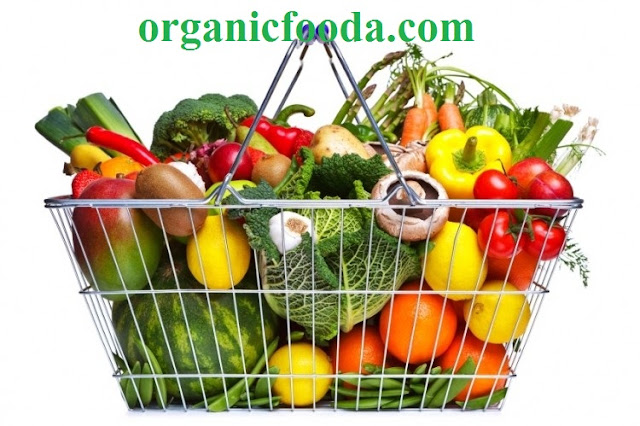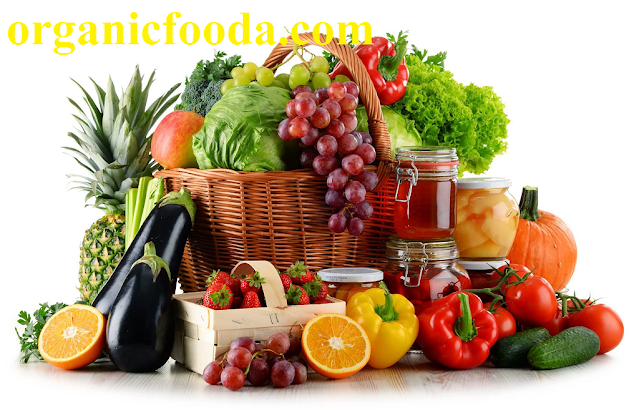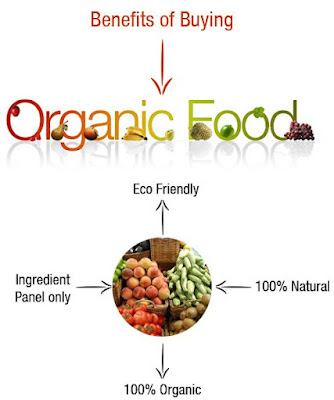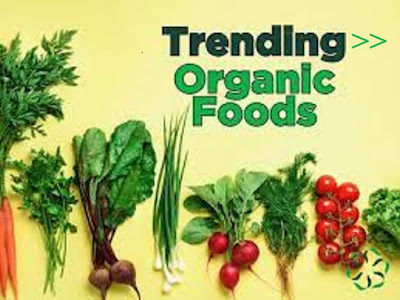Organic Food meaning: Organic
food is nutritious, fresh or processed foods produced using organic farming
methods. Processed foods include fresh produce, meat and dairy products as well
as processed foods such as crackers, drinks and frozen meals. The organic food
market has grown exponentially since the end of the 20th century, becoming a
multi-billion dollar industry with diverse production, processing, distribution
and marketing processes. Nutritious foods are grown without the use of
synthetic chemicals, such as pesticides and man-made fertilizers, and contain
no genetically modified organisms (GMOs).
Is Organic Food better? Does it give more nutrition?
Find out how organic foods differ from their
organically grown counterparts in terms of nutrition, safety and cost.
Once only available in
health food stores, organic foods are now a common feature of many grocery
stores. And it created a small problem in the production aisle.
For example, you can take
an apple grown in the first (common) method. Or you can choose one that is
organic. Both apples are firm, shiny and red. Both provide vitamins and fiber.
But none of the apples contain fat, salt or cholesterol. Which one will you
choose? Find out before shopping. What is gardening?
The word "organic" refers to the way farmers grow and organize agricultural products.
Organic products include fruits, vegetables, cereals, dairy products such as milk and cheese and meat.
Biological agricultural practices are designed to achieve the following objectives:
• Cut pollution
• Posting to control
weeds
• Sewer sludge as
fertilizer
• Insects or insect traps
to control pests
•
Improve the quality of the soil and water
• Provide safe and
healthy places for farm animals (cattle) to live
• Activate the behavior
of natural farm animals
• Promote an autonomous
resource cycle in a farm
Unauthorized materials or methods in organic farming include:
• Use of radiation
(irradiation) to preserve food or to get rid of diseases or parasites
• Artificial fertilizers
(synthetic) to add nutrients to the ground
• Most synthetic
pesticides for antiparasitic control
• Antibiotics or growth
hormones for farm animals (cattle)
• Use of genetic
technology to change the genetic composition (genetic engineering) of crops,
which can improve resistance to diseases or pests, or to improve crop crops
Organic agricultural materials or practices may include:
• Rotation of plants to
maintain the quality of the soil and stop the cycles of pests or diseases
• Plant waste left on the
fields (green manure), manure or compost of farm animals to improve the quality
of the soil
• Cover crops that
prevent soil wear (erosion) when earth sections are not used and to plow in the
soil to improve the quality of the soil
• Some natural pesticides
and some synthetic pesticides approved for organic farming, rarely used and
only as the latest choice and coordinated with a USDA biological certification
agent
Organic agricultural practices for farm animals (cattle) include:
• Organic foods for
animals
• Healthy living
conditions and outside access
• Plans to protect against
diseases (vaccinations)
• Nourish pastures for at
least 30% of the nutritional needs of farm animals during the pasture season
Check the label for Organic or not?
The United States
Department of Agriculture (USDA) has an organic certification program in place
that requires all organic foods to meet strict government standards. These
standards govern how these foods are grown, processed and processed. Any
product labeled as organic in the product description or packaging must be USDA
certified. If certified, the manufacturer may also use the official USDA
Organic label.
The USDA says that
producers who sell less than $5,000 a year in organic food do not need to be certified.
These producers must follow organic food production standards. But they don't
want to go through the certification process. They can label their products as
organic. But they cannot be labeled with the USDA Organic label.
Products obtained as 95% or more organic can display this USDA label.
USDA guidelines define organic food and product labels as:
• 100% organic: This
label is used on fruits, vegetables, eggs, meat or other organically derived
foods that contain ingredients. It can be used in food with many ingredients if
everything is organic except salt and water. These may have the USDA seal.
• Organic: If a food is
called with many organic ingredients, at least 95% of the ingredients are
certified organic, excluding salt and water. Non-organic ingredients must come
from the USDA's list of approved additives. These may also have the USDA seal.
• Organic ingredients: The ingredient list can show which
ingredients are organic. If a product has some organic ingredients but less
than 70% of the ingredients are certified organic, the product can not be
labeled as an organic product. It also can't carry a USDA seal.
• Made with materials: If
a multi-ingredient product contains at least 70% certified organic ingredients,
it can have the "made with ingredients" label. For example, a
breakfast cereal might be labeled "made with organic oats." The
ingredient list should show organic ingredients. These products cannot bear the
USDA seal.
Does "organic" mean the same as "natural"?
No, "natural" and "organic" are different. Often, "natural" on a food label means that the product has no colors, flavors, or preservatives. "Natural" on the label has nothing to do with the method or ingredients used to produce the food.
Also be careful
not to confuse other food labels with organic labels. For example, guidelines
for organically raised beef include access to pasture for at least 120 days of
grazing and no growth hormones. But the label "free" or
"hormone-free" does not mean that the farmer has followed all organic
certification standards.
Is organic food really nutritious and safe?
There is some data showing the potential health benefits of
organic foods compared to foods grown in conventional (conventional) methods.
These studies have shown differences in nutrition. But there is little
information to show how these differences can provide potential benefits for
overall health.
Possible organic food benefits include the following:
• Food: Studies have shown that the increase is small or
moderate in some foods produced organically. Products may contain more
antioxidants and flavonoids, which have antioxidant properties.
• Omega-3 fatty acids. Foods from organic farms (livestock) are
usually high in omega-3 fatty acids. These include using hay and alfalfa to
feed livestock. Omega-3 fatty acids, a type of fat, are more heart-healthy than
other fats. These omega-3 fatty acids are found in organic meats, dairy
products and eggs.
• Poison machine. Cadmium is a toxic chemical that occurs in the
soil and is absorbed by plants. Studies have shown lower levels of cadmium in
organic fruits, but not in fruits and vegetables, compared to crops grown by
(traditional) methods. The low levels of cadmium in organic corn can be linked
to the ban on synthetic fertilizers in agriculture.
• Pesticide residues: Compared to producing adults using
conventional (conventional) methods, organic crops contain less pesticide
residue. The safety rules for the highest levels of residue in conventional
products have changed. Most of the time, the levels are reduced. The produce
may contain residues from pesticides approved for agriculture or from
agricultural air pollution.
• Bacteria: Meat produced using conventional (conventional)
methods can contain large strains of dangerous bacteria that cannot be
controlled with antibiotics. The general risk of contamination of organic food
with bacteria is the same as in conventional food.
Are there discounts on organic purchases?
There is often a concern that organic food is expensive. Organic
foods often cost more than similar foods grown using conventional methods. The
high prices are, in part, due to the expensive cultivation process.
What are some tips for food safety ?
Whether you go organic or choose to mix conventional and organic
foods, keep these tips in mind:
• Choose a variety of foods from a mix of sources. You will get
a better variety of food and reduce your exposure to certain pesticides.
• Buy fruits and vegetables in season when you can. For the
freshest produce, ask your grocer what's in season. Or buy food at your local
farmer's market.
• Read food labels carefully. Just because a product says it's
organic or contains nutrients doesn't mean it's a better choice. Some organic
products can still be high in sugar, salt, fat or calories.
• Wash and rinse fresh fruit and vegetables thoroughly under
running water. Washing helps remove dirt, germs and chemical traces from fruits
and vegetables. But you won't get rid of all the antibiotics by washing them.
Disposing of the outer leaves of vegetables can reduce pollution. Cutting
fruits and vegetables can remove contaminants, but it can also reduce
nutrients.
Organic Farmers’ Market
Although organic food production began as an alternative to
conventional outdoor farming, it eventually split into two distinct categories:
(1) Small farms that may not be certified organic. These are
made, based on consumers looking for local, fresh and organic food, and
(2) Processed organic foods (fresh and processed) that are often
transported long distances and distributed through grocery store chains. If
consumers know a local farmer and trust the farmer's production methods, they
may not need a certification mark.
On the other hand, organic food produced far away from shipping
may require a certification mark to promote consumer confidence and prevent
fraud, showing how national certification standards are the most beneficial.
The
system is more important when consumers and farmers are separated from the
region, and such a system can meet the needs of large producers who participate
in the production process. This regulatory framework does not match consumer
perceptions of organic food production, which often includes images of small
family farms and humane treatment of animals.
In general, the laws surrounding food do not address complex public concerns about family farms, farmers' wages, or farm size, and organic policies in some areas do little for animal welfare.
What is Certified Organic?
The
Greater Organic Food Policy is designed to provide a certification system with
specific rules regarding production methods, and only products that comply with
the guidelines are allowed to use the certified organic label.
In
the United States, the Organic Food Production Act of 1990 began the process of
establishing regulations that could clarify how to grow, sell and label.
Organic food and product regulations are based on national lists of permitted
and prohibited substances, which are an important part of certified organic
farming methods.
The
United States Department of Agriculture (USDA) regulates organic production
through the National Organic Program (NOP), which works to support the domestic
and international markets and sales of organically produced foods to those who
buy certified organic USDA certified products that follow the same standards.
To that end, NOP has introduced three specific consumer labels on organic food
products: "100% Organic", "Organic", or "Made in ***
Organic", which indicates that the ingredients used in the product are 100
%, at least 95. %, or 70% organic, respectively. Uncertified products cannot
use the USDA organic label, and violators face significant fines and penalties.
Laws vary from country to country, with some of the most common laws found in Europe.
The objectives of organic farming in the European Union (EU) include:
1.
Respecting nature's organic systems and
establishing sustainable management systems
2.
Use water, land and air responsibly
3.
Meeting animal welfare standards that
meet the diverse behavioral needs of species.
Furthermore,
the principle of organic production in the EU is based on the organization and
management of the farm to improve the ecological system and the use of natural
resources in the agricultural system.
These
policy objectives go beyond a specific list of prohibited substances in organic
production.
Organic Food and Society
Public
concerns related to organic food include high prices for consumers and changes
in local demand. Organic foods are often more expensive to consumers than
conventionally produced foods due to their more labor-intensive methods,
certification costs, and reliance on chemicals to support crops. This often
results in unlimited access to organic food. Studies show that higher levels of
wealth and education are associated with buying organic food.
Also,
some low-income countries often produce certified organic fruit only for export
to rich countries. This sometimes results in a situation where the farmers
themselves cannot buy the organic food they produce. Although this plan may
bring short-term economic benefits, it is worrying when farmers are forced to
stop growing the food that feeds their communities, thereby increasing food
insecurity.
Certified organic farming has become
big business in many areas, with large farms playing an important role in the
national and international market for certified organic food.
Given the economies of scale, food
producers often buy from a single farm that produces crops on thousands of
acres, rather than many small farms each and -growing on small acres, a
practice that limits the participation of small farmers in these markets. There
are also differences between farmers, as the organic certification process can
be too expensive for some small farmers.
Although certification assistance is
available in some places, these farmers often choose to sell directly to
customers at farmers' markets, for example, and may decide to forgo organic
certification altogether.
In general, organic food has grown in
popularity as consumers increasingly seek out and buy foods that they believe
are healthy and grown in an environmentally friendly manner. In fact, consumers
often buy organic food to reduce their exposure to pesticides and GMOs.
In addition, some studies show that
organic crops have higher nutritional value than non-organic crops, and some
people find that organic food tastes better.
The question remains, however, whether
organic food imported from all over the world is truly a sustainable food
production method. In fact, the food produced by the local farmer who uses the
full agricultural system is sustainable in the environment, although the
economic support of such work can be difficult.
Although humans must reduce their dependence on fossil fuels to fight climate change, many organic policies do little to address sustainability issues, instead focusing on a strict list of prohibited substances, instead of seeing a vision global long term of agriculture and food.
Organic Food and Environment
The
overall impact of farming is beneficial to the environment. Certified organic
production methods prohibit the use of synthetic fertilizers and pesticides,
reducing chemical runoff and soil and water pollution. Small-scale farming is
often associated with environmental benefits, due to the use of agricultural
inputs, such as fertilizers from compost produced on site. In comparison,
large-scale organic operations often require off-site inputs and cannot use
integrated farming methods. These services can buy acceptable inputs, such as
fish emulsion or blood meal to make fertilizers instead of working in the farm
to increase soil fertility.
Although
this reduction in the use of synthetic chemicals is beneficial to the
environment compared to industrial agriculture, these methods may not promote
long-term sustainability, because the introduction of Farming requires more
fuel use than agricultural inputs.








Comments
Post a Comment